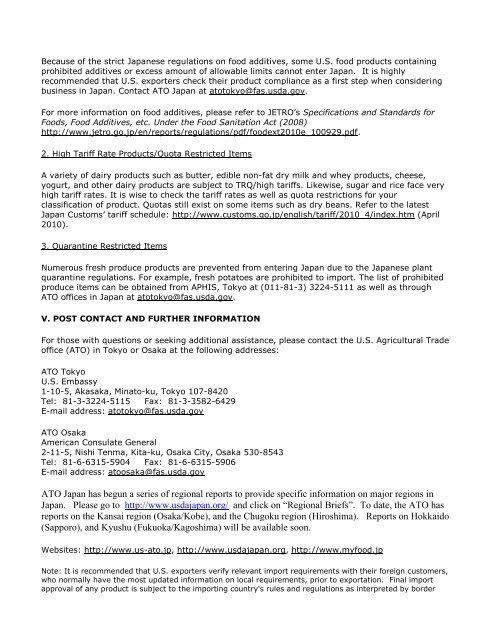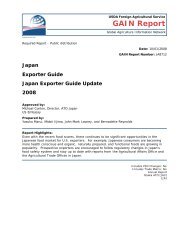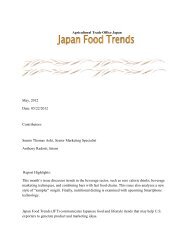Food Processing Sector Food Processing Ingredients Japan
Food Processing Sector Food Processing Ingredients Japan
Food Processing Sector Food Processing Ingredients Japan
You also want an ePaper? Increase the reach of your titles
YUMPU automatically turns print PDFs into web optimized ePapers that Google loves.
Because of the strict <strong>Japan</strong>ese regulations on food additives, some U.S. food products containing<br />
prohibited additives or excess amount of allowable limits cannot enter <strong>Japan</strong>. It is highly<br />
recommended that U.S. exporters check their product compliance as a first step when considering<br />
business in <strong>Japan</strong>. Contact ATO <strong>Japan</strong> at atotokyo@fas.usda.gov.<br />
For more information on food additives, please refer to JETRO’s Specifications and Standards for<br />
<strong>Food</strong>s, <strong>Food</strong> Additives, etc. Under the <strong>Food</strong> Sanitation Act (2008)<br />
http://www.jetro.go.jp/en/reports/regulations/pdf/foodext2010e_100929.pdf.<br />
2. High Tariff Rate Products/Quota Restricted Items<br />
A variety of dairy products such as butter, edible non-fat dry milk and whey products, cheese,<br />
yogurt, and other dairy products are subject to TRQ/high tariffs. Likewise, sugar and rice face very<br />
high tariff rates. It is wise to check the tariff rates as well as quota restrictions for your<br />
classification of product. Quotas still exist on some items such as dry beans. Refer to the latest<br />
<strong>Japan</strong> Customs’ tariff schedule: http://www.customs.go.jp/english/tariff/2010_4/index.htm (April<br />
2010).<br />
3. Quarantine Restricted Items<br />
Numerous fresh produce products are prevented from entering <strong>Japan</strong> due to the <strong>Japan</strong>ese plant<br />
quarantine regulations. For example, fresh potatoes are prohibited to import. The list of prohibited<br />
produce items can be obtained from APHIS, Tokyo at (011-81-3) 3224-5111 as well as through<br />
ATO offices in <strong>Japan</strong> at atotokyo@fas.usda.gov.<br />
V. POST CONTACT AND FURTHER INFORMATION<br />
For those with questions or seeking additional assistance, please contact the U.S. Agricultural Trade<br />
office (ATO) in Tokyo or Osaka at the following addresses:<br />
ATO Tokyo<br />
U.S. Embassy<br />
1-10-5, Akasaka, Minato-ku, Tokyo 107-8420<br />
Tel: 81-3-3224-5115 Fax: 81-3-3582-6429<br />
E-mail address: atotokyo@fas.usda.gov<br />
ATO Osaka<br />
American Consulate General<br />
2-11-5, Nishi Tenma, Kita-ku, Osaka City, Osaka 530-8543<br />
Tel: 81-6-6315-5904 Fax: 81-6-6315-5906<br />
E-mail address: atoosaka@fas.usda.gov<br />
ATO <strong>Japan</strong> has begun a series of regional reports to provide specific information on major regions in<br />
<strong>Japan</strong>. Please go to http://www.usdajapan.org/ and click on “Regional Briefs”. To date, the ATO has<br />
reports on the Kansai region (Osaka/Kobe), and the Chugoku region (Hiroshima). Reports on Hokkaido<br />
(Sapporo), and Kyushu (Fukuoka/Kagoshima) will be available soon.<br />
Websites: http://www.us-ato.jp, http://www.usdajapan.org, http://www.myfood.jp<br />
Note: It is recommended that U.S. exporters verify relevant import requirements with their foreign customers,<br />
who normally have the most updated information on local requirements, prior to exportation. Final import<br />
approval of any product is subject to the importing country's rules and regulations as interpreted by border





